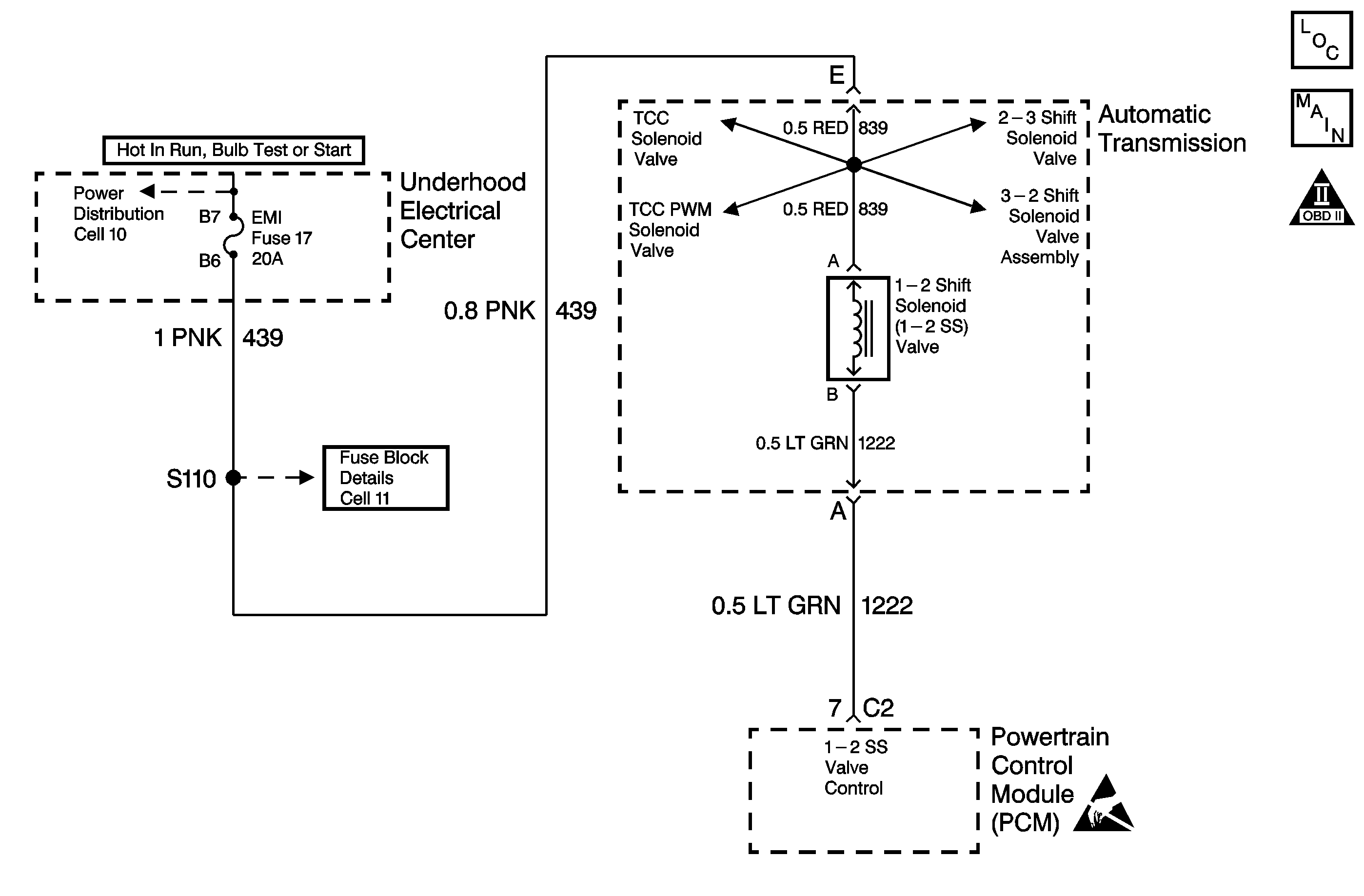
Circuit Description
The 1-2 Shift Solenoid Valve (1-2 SS Valve) controls the fluid flow acting on the 1-2 and 3-4 shift valve. The solenoid is a normally-open exhaust valve. The combination of the 2-3 Shift Solenoid Valve and the 1-2 SS Valve allows four different shifting combinations. The solenoid attaches to the control valve body within the transmission. Circuit 439 supplies ignition voltage directly to the 1-2 SS Valve. The PCM controls the solenoid by providing a ground path through circuit 1222.
If the PCM detects a continuous open or a short to ground in the 1-2 SS Valve circuit or the 1-2 SS Valve, then DTC P0753 sets. DTC P0753 is a type A DTC.
Conditions for Setting the DTC
| • | The ignition is ON. |
| • | The system voltage is 10-17 volts. |
| • | The PCM commands the solenoid ON and the voltage remains high (Battery Positive Voltage). |
| • | The PCM commands the solenoid OFF and the voltage remains low (0 volts). |
| • | All conditions met for 5 seconds. |
Action Taken When the DTC Sets
| • | The PCM commands maximum line pressure. |
| • | The PCM freezes shift adapts from being updated. |
| • | The PCM illuminates the Malfunction Indicator Lamp (MIL). |
Conditions for Clearing the MIL/DTC
| • | The PCM turns OFF the MIL after three consecutive ignition cycles without a failure reported. |
| • | A scan tool can clear the DTC from the PCM history. The PCM clears the DTC from the PCM history if the vehicle completes 40 warm-up cycles without a failure reported. |
| • | The PCM cancels the DTC default actions when the fault no longer exists and the ignition is OFF long enough in order to power down the PCM. |
Diagnostic Aids
| • | Inspect the wiring for any poor electrical connections at the PCM. Inspect the wiring at the TCC brake switch. Look for the following conditions: |
| - | A bent terminal |
| - | A backed out terminal |
| - | A damaged terminal |
| - | Poor terminal tension |
| - | A chafed wire |
| - | A broken wire inside the insulation |
| • | When diagnosing for an intermittent short or an open condition, massage the wiring harness while watching the test equipment for a change. |
| • | An open feed circuit can set multiple DTCs. |
| • | Refer to Shift Solenoid Valve State and Gear Ratio . |
Test Description
The numbers below refer to the step numbers on the diagnostic table.
-
This step verifies that the 1-2 SS Valve and the Automatic Transmission Wiring Harness Assembly are functioning normally.
-
This step verifies that the ignition supplies power to the 1-2 SS Valve through the PCM Emissions fuse.
-
This step verifies that the valve's resistance is within specifications.
Step | Action | Value(s) | Yes | No | ||||||||||||
|---|---|---|---|---|---|---|---|---|---|---|---|---|---|---|---|---|
1 | Was the Powertrain On-Board Diagnostic (OBD) System Check performed? | -- | Go to Powertrain On Board Diagnostic (OBD) System Check , Section 6. | |||||||||||||
2 |
Important: Before clearing the DTCs, use the scan tool in order to record the Freeze Frame and Failure Records for reference. The Clear Info function will erase the data. | -- | ||||||||||||||
3 |
Refer to Electrical Diagnosis, Section 8. Did you find and correct a problem? | -- | -- | |||||||||||||
Using the scan tool, command the 1-2 SS Valve ON and OFF three times while listening to the bottom of the transmission pan (a stethoscope may be necessary). Did the solenoid click when commanded? | -- | |||||||||||||||
5 |
Did you find and correct a problem? | -- | Go to Diagnostic Aids | |||||||||||||
Did the test lamp Illuminate? | -- | |||||||||||||||
7 |
Does the test lamp illuminate when you command the solenoid valve ON, and turn OFF when you command the solenoid valve OFF? | -- | ||||||||||||||
8 | Repair the open or short to ground in the ignition feed circuit 439 (PNK) to the 1-2 SS Valve. Refer to Electrical Diagnosis, Section 8. Did you find and correct a problem? | -- | -- | |||||||||||||
9 | Monitor the test lamp. Was the test lamp OFF continuously? | -- | ||||||||||||||
10 |
Refer to Electrical Diagnosis, Section 8. Did you find and correct a problem? | -- | ||||||||||||||
11 | Was the test lamp illuminated continuously? | -- | -- | |||||||||||||
12 |
Refer to Electrical Diagnosis, Section 8. Did you find and correct a problem? | -- | ||||||||||||||
13 |
Did you find and correct a problem? | -- | ||||||||||||||
14 |
Are both readings greater than the specified value? | 250kohms | ||||||||||||||
15 |
Is the resistance within the specified range? | 19-31ohms | Go to Diagnostic Aids | |||||||||||||
Is the resistance within the specified range? | 19-31ohms | |||||||||||||||
17 |
Refer to Electrical Diagnosis, Section 8. Did you find and correct a problem? | -- | -- | |||||||||||||
18 |
Are both readings greater than the specified value? | 250kohms | ||||||||||||||
19 |
Refer to Electrical Diagnosis, Section 8. Did you find and correct a problem? | -- | -- | |||||||||||||
20 | Replace the 1-2 SS Valve. Refer to Control Valve Body and Pressure Switch, in On-Vehicle Service. Is the replacement complete? | -- | -- | |||||||||||||
21 | Replace the PCM. Refer to Powertrain Control Module Replacement/Programming , Section 6. Is the replacement complete? | -- | -- | |||||||||||||
22 |
Has the test run and passed? | -- | System OK |
